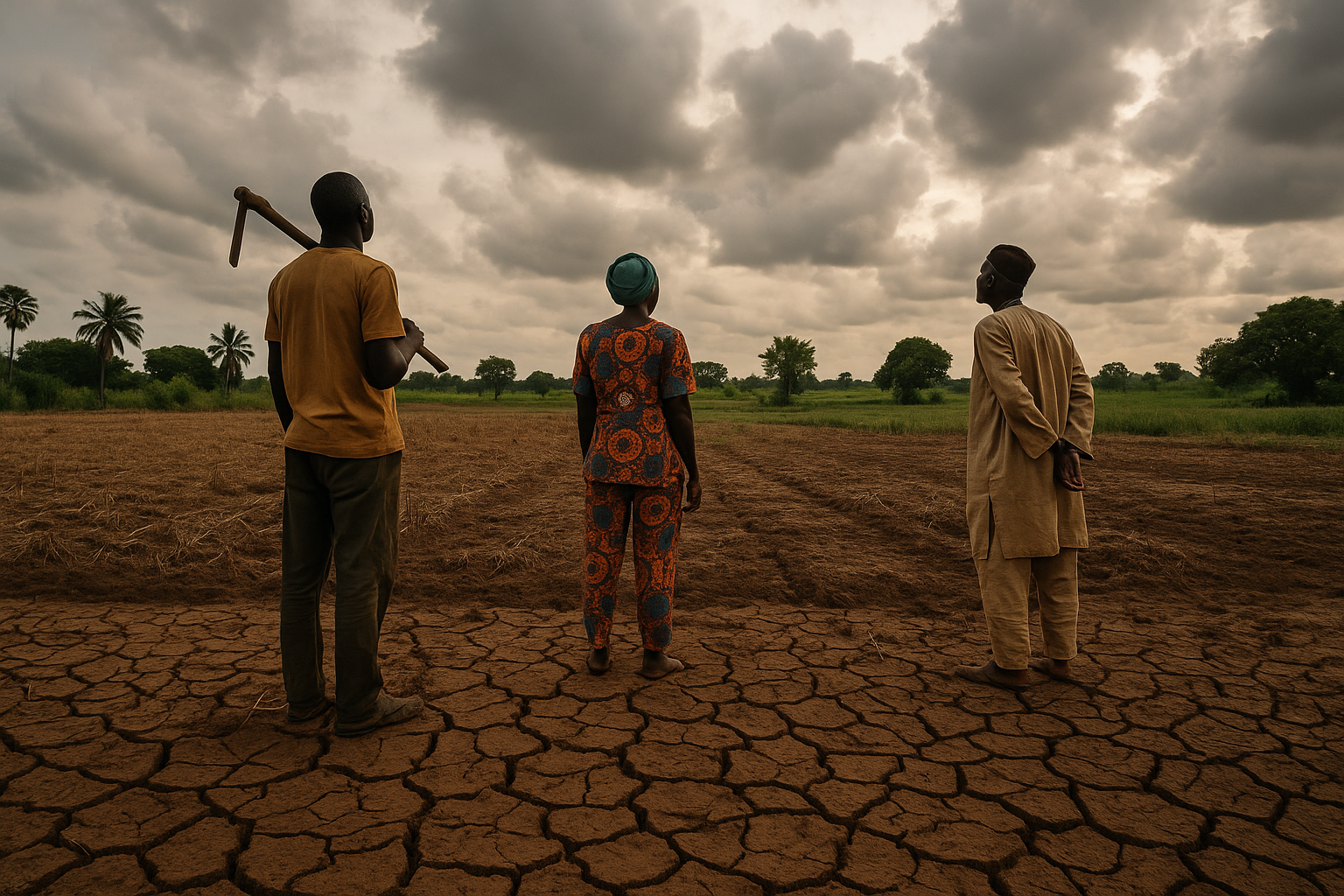Introduction: Separating Fact from Fiction in Nigeria’s Climate Reality
In boardrooms across Lagos, Abuja, and Port Harcourt, business owners and entrepreneurs often hear about climate change as a distant threat—something happening to polar bears in the Arctic or low-lying islands in the Pacific. Meanwhile, skeptics dismiss it as “another husk,” just empty talk designed to distract from more pressing economic concerns. But for millions of Nigerians living in rural communities, climate change isn’t a future threat or political rhetoric. It’s a daily reality that’s reshaping their lives, livelihoods, and futures in profound ways.
This comprehensive analysis examines the tangible evidence of climate change impacts on rural Nigerian communities, moving beyond speculation to explore documented effects on agriculture, water resources, food security, and economic stability. Whether you’re a business owner sourcing agricultural products, a startup founder looking to understand market disruptions, or an entrepreneur seeking investment opportunities in climate adaptation, understanding these realities is no longer optional—it’s essential for sustainable business planning.
The question isn’t whether climate change is affecting rural Nigeria. The evidence is overwhelming. The real question is: what does this mean for your business, and how can understanding these changes create opportunities rather than obstacles?
The Hard Evidence: Climate Change Impacts Are Measurable and Documented
Temperature and Rainfall: The Numbers Don’t Lie
Nigeria is highly exposed to climate change, particularly through the vulnerability of its agriculture, with projections showing temperatures could rise between 2.9°C and 5.7°C under very high emissions scenarios. These aren’t hypothetical projections—they’re already manifesting in measurable ways across rural communities.
Climate change in Nigeria has caused increasing temperatures and rainfall variability, with rainfall increasing in coastal areas and declining in continental areas, resulting in drought, desertification, rising sea levels, erosion, floods, and more frequent extreme weather conditions. The northern regions experience longer dry spells while the south faces unpredictable rainy seasons, creating a perfect storm of agricultural disruption.
The rainy season in the north has dropped to 120 days from an average of 150 days over the last 30 years, reducing food production in the region by 20 percent. This isn’t a minor fluctuation—it represents a fundamental shift in the agricultural calendar that rural farmers have relied upon for generations.
The Devastation of Flooding: Recent Evidence
Perhaps the most visible and devastating evidence of climate change’s impact on rural communities comes from Nigeria’s catastrophic flooding events. The 2022 floods were the worst since 2012, affecting 33 of Nigeria’s 36 states, with over two million people affected and more than 600 people killed.
The impacts of the 2022 floods were significantly higher in rural areas, with 74 percent of rural households affected compared to about 40 percent in urban areas. This rural-urban disparity reveals a crucial reality: while cities have infrastructure and resources to cope with climate disasters, rural communities bear the brunt of climate impacts with far fewer support systems.
The pattern continued in 2024. More than 1.7 million people across 185 local government jurisdictions in Nigeria were impacted by flooding in 2024, with at least 200,000 people displaced. The Alau Dam burst in September 2024, flooding approximately 70 percent of Maiduguri and displacing over 640,000 people in Borno state alone, including 150,000 children.
Climate modeling studies found that due to human-caused global warming, similar flooding events are no longer rare and are expected to become even more frequent with further warming. This isn’t speculation—it’s scientifically verified attribution connecting these specific disasters to climate change.
Desertification: The Silent Catastrophe in Northern Nigeria
While floods grab headlines, a quieter but equally devastating climate impact is transforming northern Nigeria: desertification. Nigeria loses up to 350,000 hectares of land annually to desert encroachment, resulting in demographic displacements across 11 northern states, with the country losing approximately $5.1 billion every year.
Desertification affects as much as 60 percent of Nigeria’s land, exacerbated by drought and climate change. This represents an existential threat to agricultural productivity and rural livelihoods in a vast portion of the country.
Rural farmers are witnessing this transformation firsthand. In Yobe State’s remote communities near the Niger border, farmers report that the desert has consumed multiple farms, with one village head stating that up to 10 farms belonging to him, his brothers, and his father have been swallowed by advancing sand dunes.
The impacts extend beyond lost farmland. The depletion of vegetation has affected rainfall patterns, with farmers noting that although heavy rains occurred two years prior, rainfall volumes have been dismal in recent years. Climate change creates a vicious cycle: reduced vegetation leads to less rainfall, which accelerates desertification, which further reduces vegetation.
The Agricultural Crisis: How Climate Change Threatens Food Security
Crop Failures and Yield Reductions
Agriculture remains the backbone of Nigeria’s rural economy, yet climate change is systematically undermining agricultural productivity. The majority of Nigeria’s population relies on subsistence farming, growing crops such as maize, cassava, yams, and millet, with changing climate posing multiple challenges including longer dry spells and unpredictable rainy seasons.
Vulnerable crops such as maize, cassava, and rice are particularly affected by climate change, with erratic rainfall, rising temperatures, and extreme weather events leading to reduced crop yields, increased pest and disease pressure, and land degradation.
Studies have shown that basic crops like maize and sorghum have suffered yield decreases of up to 30 percent in certain areas due to climate change impacts. For rural farming communities operating on thin margins, a 30 percent yield reduction can mean the difference between survival and destitution.
The 2022 floods alone caused immense agricultural damage. Nearly 100,000 homes were destroyed and more than 315,100 acres of farmland were washed away because of the flooding, with experts warning the flooding would severely exacerbate food insecurity.
The Human Cost: Rural Farmers’ Stories
Behind the statistics are real people facing impossible choices. Small-scale rural farmers lost their crops and harvests in the floods, losing most if not all of their income and food for the coming year, with survival after floods being particularly tough for families who have long had to live from hand to mouth even in normal conditions.
One farmer’s experience illustrates the devastating personal impact: A rural farmer reported that floods washed away her family’s cassava, vegetables, and sugar cane crops, with the farmer stating that next year would be very hard to eat as everything in their farm had been destroyed.
In northwestern Nigeria’s Sokoto State, one farmer lost a large portion of his crops to desertification and drought, getting only 25 to 30 bags of yield instead of the expected 200 bags, causing him to consider abandoning his farmland. These aren’t isolated incidents—they represent the new reality for millions of rural farmers.
Food Price Inflation and Economic Impacts
Climate impacts on rural agriculture don’t stay confined to farming communities—they ripple throughout the entire economy. Food inflation in Nigeria is expected to be around 20 percent in 2025 and 17 percent in 2026, yet this doesn’t guarantee improved food security for a population where more than half live on less than USD 2 a day.
Nigeria spent USD 689.88 million on food imports in the first quarter of 2024, representing 17 percent of total foreign currency expenditure on imports and a 40 percent increase from the previous quarter. As rural agricultural production declines due to climate impacts, Nigeria becomes increasingly dependent on expensive food imports, creating economic vulnerability and food insecurity.
For businesses, this translates into direct operational challenges. Major agricultural businesses are feeling the impacts, with Olam Nigeria, which produces a quarter of Nigeria’s rice, reporting that 10,000 acres of farmland were submerged in floods, leading to shortfalls that could raise rice prices.
Water Resources: The Foundation of Rural Life Under Threat
Shrinking Lakes and Rivers
Climate change affects water resources characteristics due to rising sea levels and extreme weather events, with increased salinity and shrinking lakes and rivers threatening inland fisheries viability. For rural communities dependent on fishing for protein and income, these changes represent an existential threat.
The fishery sub-sector contributes about 3-4 percent to Nigeria’s annual GDP and constitutes about 50 percent of animal protein intake, with the Nigerian Fisheries Statistical Bulletin estimating approximately 3.2 million persons were working in the industry in 2019. Rural and coastal communities depend heavily on this sector for livelihoods and nutritional security.
Groundwater Challenges and Drought
Water scarcity extends beyond surface water. Rural farmers report that accessing groundwater has become significantly more difficult, requiring extra effort compared to previous conditions, with the loose nature of desert soil affecting water flow from boreholes.
Nigeria faces water scarcity and droughts which occur every five years on average, with the potential to increase in frequency due to climate change, particularly affecting the extreme north where persistent water shortages continue to exacerbate land degradation, desertification, and habitat loss.
The Migration Crisis: Climate Refugees Within Nigeria
Rural-Urban Migration
The situation is forcing many farmers to migrate to urban areas, adding to pressure on infrastructures, most of which are already outdated, with internal climate migration potentially affecting 9.4 million people by 2050 in a pessimistic scenario.
This isn’t just a rural problem—it creates cascading challenges for urban areas ill-equipped to absorb massive population influxes. For businesses, this represents both disruption to rural supply chains and pressure on urban infrastructure and services.
Herder-Farmer Conflicts
Droughts and desertification have significantly impacted northern Nigerian communities relying on rain-fed farming, with nomadic herders moving south in search of better grazing areas as water and fertile land become scarcer, leading to conflicts with local farmers over limited resources.
Cattle herders from northern Nigeria have been pushed farther south to find land to graze livestock, causing friction with farmers settled in central states, with clashes killing tens of thousands across the Sahel region. Climate change isn’t just an environmental issue—it’s a security and stability issue with profound business implications.
Addressing Skepticism: Why This Isn’t “Another Husk”
Scientific Attribution and Verification
Climate skeptics often dismiss extreme weather events as natural variations, but scientific attribution studies directly link Nigeria’s recent disasters to human-caused climate change. United Nations Humanitarian Coordinator for Nigeria stated that the 2022 flooding could be largely explained by climate change, with climate modeling studies estimating that floods were rendered far more likely and much more intense by climate change.
These aren’t assumptions—they’re peer-reviewed scientific analyses using sophisticated climate models to determine the probability and intensity of specific events with and without anthropogenic climate forcing.
The Pattern of Increasing Frequency
The floods in Nigeria, Niger, and Cameroon in 2024 were nearly identical in timing and spatial extent to the floods that hit the same region in 2022, with attribution studies finding that similar events are no longer rare and are expected to become even more frequent.
When the same unprecedented “once in a century” events occur twice within two years in exactly the same locations, dismissing them as random coincidence becomes scientifically untenable.
Local Knowledge and Observation
Perhaps most compellingly, rural communities themselves—people who have lived on and worked the land for generations—report unmistakable changes. Rural farmers and community leaders report that climate strain has been exacerbated by rising temperatures, with higher temperatures changing growth patterns of plants with strong roots that previously prevented topsoil from being blown away by wind.
These aren’t abstract climate models—they’re observable, lived experiences of ecological transformation.
The Knowledge Gap: Understanding Without Acting
Public Awareness Versus Understanding
While 87 percent of academic studies on Nigeria’s climate policies highlight growing awareness, only about 28 percent of the general public can accurately explain what drives climate change. This knowledge gap creates a dangerous situation where people experience climate impacts without understanding their causes or how to effectively adapt.
Rural communities, while deeply affected by climate disasters, often lack access to clear information, with many farmers attributing erratic rainfall patterns to divine will rather than global warming. This disconnect between experience and understanding hinders effective adaptation responses.
The Supernatural Attribution Problem
A survey of 1,019 people in rural communities in southwestern Nigeria found respondents had good knowledge about climate change effects but poor knowledge about causes, with many attributing supernatural causes to climate change. Without accurate understanding of causation, rural communities struggle to implement effective adaptation strategies.
Business Implications: Why This Matters for Entrepreneurs and Investors
Supply Chain Disruption
For business owners sourcing agricultural inputs or products from rural Nigeria, climate impacts create unpredictable supply chain disruptions. Agricultural losses could account for between 2 to 4 percent of GDP in West Africa by 2100 with population growth, while flooding threatens onshore oil and gas production, impacting export revenues and electricity generation.
These aren’t distant future concerns—they’re current operational realities affecting businesses today. The rice price increases following Olam Nigeria’s flood losses demonstrate how quickly rural climate impacts translate into urban business challenges.
Food Security and Market Volatility
Climate change in Northern Nigeria is marked by very high temperatures, drought, flooding, desertification, and relatively low total annual rainfall, all of which have significant impact on livelihoods, the economy, and future food availability in the region.
For businesses in food production, processing, distribution, or retail, understanding these climate-driven supply disruptions becomes essential for risk management and strategic planning. The 20 percent food inflation projected for 2025 will affect consumer purchasing power, business costs, and market dynamics across sectors.
Labor Market Transformations
Rural children may remain out of school for entire academic years following climate disasters, potentially joining the labor force as families struggle with basic survival, with education becoming the least of their worries when starting over.
This creates long-term human capital implications that extend far beyond immediate disaster impacts, affecting the quality and availability of future workforce across industries.
Adaptation Strategies: What Rural Communities Are Already Doing
Indigenous and Contemporary Innovation
Findings reveal that rural farmers predominantly rely on indigenous production practices alongside contemporary innovations, with income, education, and extension services identified as critical determinants for successful adaptation.
Rural communities aren’t passive victims—they’re actively adapting using both traditional knowledge and new technologies. However, their efforts are constrained by limited resources and support systems.
Support Needs and Interventions
With agriculture employing nearly 40 percent of Nigerians, 81 percent of farmers support initiatives that provide drought-resistant seeds and irrigation training, viewing climate adaptation as a matter of survival rather than a political issue.
After devastating floods, 76 percent of urban residents and 89 percent of rural communities ranked flood prevention as a top priority, with many considering this more pressing than reducing carbon emissions. This reveals a crucial insight: rural communities prioritize practical adaptation over abstract mitigation discussions.
Government and International Response
The World Bank approved a $700 million credit for the Nigeria Agro-Climatic Resilience in Semi-Arid Landscapes Project to increase sustainable landscape management practices in northern Nigeria and strengthen long-term enabling environment for integrated climate-resilient landscape management.
Nigeria has established several initiatives in the agriculture sector to combat desertification including afforestation and reforestation programs, dissemination of proven agricultural technologies and sustainable agricultural practices, and promotion of efficient energy sources.
However, implementation challenges remain significant. Between 2012 and 2021, NGN 548 billion was allocated to environmental funding, raising concerns about corruption and whether funds reach intended beneficiaries.
Business Opportunities in Climate Adaptation
Agricultural Technology and Innovation
The climate crisis affecting rural communities creates substantial opportunities for innovative businesses. Drought-resistant crop varieties, efficient irrigation systems, climate-smart agricultural practices, and early warning systems for extreme weather all represent growing market opportunities.
About 68 percent of Nigerians favor large-scale solar investments, particularly in off-grid rural communities, with the government’s plan to bring solar power to 5 million homes by 2025 receiving overwhelming approval in areas where blackouts are routine. Solar-powered irrigation, refrigeration for agricultural products, and village electrification represent viable business opportunities aligned with climate adaptation needs.
Financial Services and Insurance
In Nigeria, access to formal banking has grown from 56 percent in 2022 to 64 percent in 2023, with programs trialing anticipatory cash transfers using AI to identify those most at risk of floods before disasters hit.
Climate-indexed insurance products, mobile banking solutions for rural areas, and microfinance adapted to climate-variable agricultural cycles all represent underserved markets with substantial growth potential.
Supply Chain Resilience Services
Businesses helping other companies diversify agricultural sourcing, develop climate-resilient supply chains, or access alternative suppliers during climate disruptions can create value while building systemic resilience.
Policy Recommendations and Strategic Imperatives
For Business Leaders
- Integrate Climate Risk Assessment: Incorporate rural climate impacts into supply chain risk assessments and business continuity planning
- Diversify Agricultural Sourcing: Reduce dependence on single-source suppliers vulnerable to localized climate impacts
- Invest in Climate Adaptation: Consider investments in agricultural technology, water management, and renewable energy as both social responsibility and business opportunity
- Engage Rural Communities: Build direct relationships with rural suppliers to understand their climate challenges and support adaptation efforts
For Government and Policy Makers
There is a need for government to strengthen policies and increase public investment in building institutions towards a more resilient system, with climate change posing a significant threat to food security requiring developmental strategies for mitigation and adaptation.
Government-designed tree planting projects without input from local farmers and key rural stakeholders are not sustainable, with rural dwellers’ buy-in essential for stewardship, ownership and sustainability.
Effective climate adaptation requires genuine community engagement, adequate funding that reaches intended beneficiaries, integration of indigenous and scientific knowledge, infrastructure investment in water management and irrigation, and support for climate-smart agriculture extension services.
The Recovery Challenge: Why Action Is Urgent
The 2022 flood assessment shows low recovery rates among affected communities, underscoring the urgent need for planned recovery efforts and future resilience building. Rural communities aren’t bouncing back between disasters—they’re being progressively weakened by each successive climate shock.
Over 90 percent of national food production depends on smallholder farmers who lack capacity to increase food production without degrading land, complicating efforts to combat desertification while feeding a rapidly increasing population in a region where natural resources are dwindling.
This creates a development trap: rural communities need to increase productivity to survive, but the methods available to them often accelerate land degradation, which worsens climate vulnerability, creating a downward spiral.
Conclusion: From Skepticism to Strategic Action
The question posed at this article’s outset—whether climate change is really affecting rural Nigerian communities or just “another husk”—has been definitively answered. The evidence is overwhelming, measurable, and documented across multiple independent sources: from scientific climate models to government assessments, from international humanitarian organizations to the lived experiences of rural farmers themselves.
Climate change isn’t abstract theory or distant future threat for rural Nigeria—it’s current reality manifesting in catastrophic floods, advancing deserts, crop failures, water scarcity, forced migration, and food insecurity. Nigeria is identified as one of the top ten most exposed countries to climate change effects, with about 6 percent of its land area estimated to be exposed to extreme weather events.
For business owners, entrepreneurs, and investors, this reality creates both risks and opportunities. Supply chains will be disrupted. Food prices will increase. Labor markets will transform. But companies that understand these dynamics and position themselves to support adaptation—through agricultural innovation, renewable energy, water management, climate-indexed financial services, or supply chain resilience—can create sustainable value while contributing to solutions.
The choice isn’t between acknowledging climate impacts or maintaining business as usual. Climate change is already transforming rural Nigeria’s agricultural landscape, water resources, and community stability. The only choice is whether businesses will respond reactively to each crisis as it unfolds or proactively position themselves to thrive in a climate-changed world.
Rural Nigerian communities are adapting, innovating, and surviving despite extraordinary challenges. The question for business leaders is simple: Will you recognize their reality, support their adaptation, and build resilience together? Or will you continue treating climate change as “another husk” until the next supply chain disruption, food price shock, or rural labor crisis forces recognition?
The evidence is clear. The impacts are real. The time for strategic action is now.
References
- Direction générale du Trésor. (2024). What is the economic impact of climate change in Nigeria? Retrieved from https://www.tresor.economie.gouv.fr/Articles/2024/09/19/what-is-the-economic-impact-of-the-climate-change-in-nigeria
- Wikipedia. (2024). Climate change in Nigeria. Retrieved from https://en.wikipedia.org/wiki/Climate_change_in_Nigeria
- Izuogu, C.U., et al. (2025). Rural-Farmers’ Response to Climate Change in Nigeria—A Review. In: Climate Change Impacts on Nigeria. Springer. Retrieved from https://link.springer.com/chapter/10.1007/978-3-031-83165-2_26
- Akinkuolie, T.A., Ogunbode, T.O., & Adekiya, A.O. (2025). Resilience to climate-induced food insecurity in Nigeria: A systematic review. Frontiers in Sustainable Food Systems. Retrieved from https://www.frontiersin.org/journals/sustainable-food-systems/articles/10.3389/fsufs.2024.1490133/full
- Climate Action Tracker. (2024). Nigeria. Retrieved from https://climateactiontracker.org/countries/nigeria/
- International Organization for Migration. (2024). Nigeria — Impact of Climate Change and Environmental Changes on Displaced Households. Retrieved from https://dtm.iom.int/reports/nigeria-impact-climate-change-and-environmental-changes-displaced-households-june-2024
- Okon, E.M., et al. (2021). Systematic review of climate change impact research in Nigeria: Implication for sustainable development. Heliyon. Retrieved from https://www.ncbi.nlm.nih.gov/pmc/articles/PMC8436081/
- ScienceDirect. (2025). Multi-impacts of climate change and mitigation strategies in Nigeria: Agricultural production and food security. Retrieved from https://www.sciencedirect.com/science/article/pii/S2949704325000101
- Springer. (2024). Climate Change Impacts on Nigeria: Environment and Sustainable Development. Retrieved from https://link.springer.com/book/10.1007/978-3-031-21007-5
- Climate Scorecard. (2025). Nigeria: What Recent Climate Polling Tells Us. Retrieved from https://www.climatescorecard.org/2025/09/nigeria-what-recent-climate-polling-tells-us/
- National Bureau of Statistics Nigeria. (2023). Nigeria Flood Impact, Recovery and Mitigation Assessment Report 2022-2023. Retrieved from https://www.nigerianstat.gov.ng/elibrary/read/1241417
- Center for Disaster Philanthropy. (2024). 2024 West and Central Africa Floods. Retrieved from https://disasterphilanthropy.org/disasters/2024-west-and-central-africa-floods/
- Harvard Economic History. (2022). There is a Flood in Nigeria – Visualizing Climate and Loss. Retrieved from https://histecon.fas.harvard.edu/climate-loss/flood/index.html
- Wikipedia. (2025). 2022 Nigeria floods. Retrieved from https://en.wikipedia.org/wiki/2022_Nigeria_floods
- International Recovery Platform. (2023). Nigeria Flood Impact, Recovery and Mitigation Assessment Report. Retrieved from https://recovery.preventionweb.net/publication/nigeria-flood-impact-recovery-and-mitigation-assessment-report-2022-2023
- World Economic Forum. (2022). Nigeria’s most devastating floods in a decade causing displacements. Retrieved from https://www.weforum.org/stories/2022/10/nigeria-flood-rain-climate/
- ReliefWeb. (2022). Nigeria: Floods – Jun 2022. Retrieved from https://reliefweb.int/disaster/fl-2022-000271-nga
- International Rescue Committee. (2024). Devastating flooding in Nigeria: IRC launches emergency response. Retrieved from https://www.rescue.org/press-release/devastating-flooding-nigeria-irc-launches-emergency-response
- Al Jazeera. (2024). Floods in Nigeria kill at least 49, displace thousands. Retrieved from https://www.aljazeera.com/news/2024/8/26/floods-in-nigeria-kill-displace-thousands
- World Weather Attribution. (2024). Conflict, poverty and water management issues exposing vulnerable communities in Africa to extreme floods. Retrieved from https://www.worldweatherattribution.org/conflict-poverty-and-water-management-issues-exposing-vulnerable-communities-in-africa-to-extreme-floods-that-are-now-common-events-because-of-climate-change/
- Al Jazeera. (2024). Desert swallows livelihoods as climate shocks continue in northeast Nigeria. Retrieved from https://www.aljazeera.com/features/2024/1/5/desert-swallows-livelihoods-as-climate-shocks-continue-in-northeast-nigeria
- The New Humanitarian. (2022). Briefing: Nigerian farmers can’t fight desertification alone. Retrieved from https://www.thenewhumanitarian.org/analysis/2017/11/14/briefing-nigerian-farmers-can-t-fight-desertification-alone
- TIME Magazine. (2018). Land Conflict Has Long Been a Problem in Nigeria. Here’s How Climate Change Is Making It Worse. Retrieved from https://time.com/5324712/climate-change-nigeria/
- ResearchGate. (2018). Desertification in Northern Nigeria: Causes and Consequences. Retrieved from https://www.researchgate.net/publication/354423993_Desertification_in_Northern_Nigeria_Causes_and_Consequences
- Wikipedia. (2025). Desertification in Nigeria. Retrieved from https://en.wikipedia.org/wiki/Desertification_in_Nigeria
- ScienceDirect. (2020). Impacts of land cover changes on desertification in northern Nigeria and implications on the Lake Chad Basin. Retrieved from https://www.sciencedirect.com/science/article/abs/pii/S014019632030094X
- Wikipedia. (2024). Climate change in Nigeria. Retrieved from https://en.wikipedia.org/wiki/Climate_change_in_Nigeria
- Climate Change Writers. (2024). Desertification In Nigeria and Its Impact On Climate Change. Retrieved from https://www.climatechangewriters.com/stories/desertification-in-nigeria-and-its-impact-on-climate-change-2
- PreventionWeb. (2021). Nigeria: New project to build a climate-resilient landscape. Retrieved from https://www.preventionweb.net/news/new-project-build-climate-resilient-landscape-nigeria
- ScienceDirect. (2022). Agriculture and food security in Northern Nigeria, Part I: The implications of climate change. Retrieved from https://www.sciencedirect.com/science/article/abs/pii/S2452263522000064




